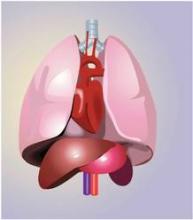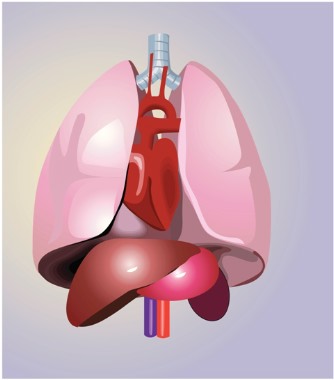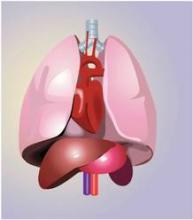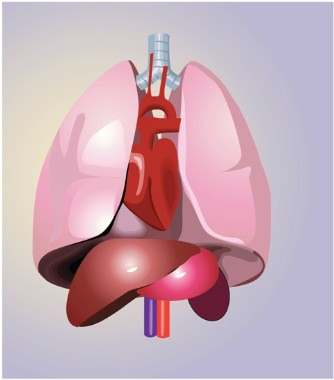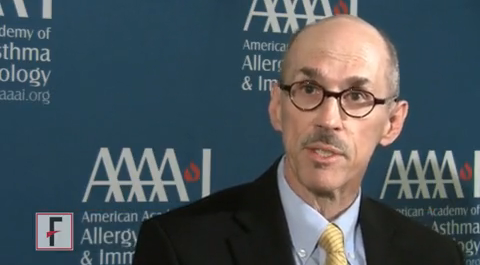User login
American Academy of Allergy, Asthma, & Immunology (AAAAI): Annual Meeting
Phytoestrogens may be helpful in asthma and allergy
SAN DIEGO – Could increased consumption of phytoestrogens help prevent or treat asthma and allergy?
Dr. Jessica Savage, an allergist and immunologist at Brigham and Women’s Hospital, Boston, and her colleagues correlated one-time urinary phytoestrogen measurements from 7,909 subjects in the National Health and Nutrition Examination Survey, 2003-2010, with histories of physician-diagnosed asthma and self-reported wheezing.
The investigators also considered serum total and specific IgE levels obtained from a subset of 2,218 subjects. They defined atopy as having at least one positive IgE level (0.35 kU/L or above) to an aeroallergen.
Adjusting for a wide range of potential cofounders, including age, gender, race, urinary creatinine, poverty, body mass index, smoking, and smoke exposure, they found that, for every natural log increase in urinary enterolactone, the odds of asthma decreased by 8%.
Enterolactone also was significantly inversely associated with asthma prevalence and had the strongest inverse association with wheezing.
For every natural log increase in urinary o-desmethylangolensin (ODMA), there was a 7% decrease in the odds of wheeze. The odds of atopy significantly decreased with increasing ODMA levels.
"We can’t say anything about cause and effect" yet, but if the association holds up with further investigation, it might suggest a role for phytoestrogen probiotics to help treat the conditions, Dr. Savage said at the annual meeting of the American Academy of Allergy, Asthma, and Immunology.
Phytoestrogens are plant-derived compounds. Gut bacteria convert lignans, which are particularly plentiful in flax seeds, into enterolactone, and the isoflavone daidzein, particularly plentiful in soybeans, into ODMA.
"Increased consumption of sources of phytoestrogens or probiotics to increase precursor conversion may help prevent or treat asthma and allergic disease," Dr. Savage said. "I was really surprised that the enterolactone signal is very strong both for asthma and for wheezing."
Although soy-derived compounds have been associated with better lung function and decreased lung symptoms in the past, "there’s really not a lot known about enterolactone," she said. "The idea is that somehow these metabolites are anti-inflammatory. Urinary levels are partly due to your diet and partly to having the right bacterial flora in your gut. Our findings could be explained by people just having different diets; they could also be explained by people with asthma having lower levels of the right kind of bacteria."
About half the subjects were female, and about 80% were over age 18 years; 70% of the study population was white. Enterolactone tertiles were defined as 0.2-178; 179-644; and 645-122,000 ng/mL urine. ODMA tertiles were defined as 0.1-1.4; 1.5-12.8; and 12.9-18,500 ng/mL urine.
The study was funded by the National Institutes of Health. The investigators reported having no disclosures.
Dr. Jennifer Cox, FCCP, comments: It is a novel idea that phytoestrogens could prevent or treat allergy and asthma. However,the this study population had few pediatric subjects, the majority of patients were white, and it was a one-time measurement. Before we recommend to our patients to increase consumption of phytoestrogens, further research to include pediatric patients, a more diverse ethnic background, and frequent monitoring of urinary levels will be helpful to document if there is a true cause and effect.
SAN DIEGO – Could increased consumption of phytoestrogens help prevent or treat asthma and allergy?
Dr. Jessica Savage, an allergist and immunologist at Brigham and Women’s Hospital, Boston, and her colleagues correlated one-time urinary phytoestrogen measurements from 7,909 subjects in the National Health and Nutrition Examination Survey, 2003-2010, with histories of physician-diagnosed asthma and self-reported wheezing.
The investigators also considered serum total and specific IgE levels obtained from a subset of 2,218 subjects. They defined atopy as having at least one positive IgE level (0.35 kU/L or above) to an aeroallergen.
Adjusting for a wide range of potential cofounders, including age, gender, race, urinary creatinine, poverty, body mass index, smoking, and smoke exposure, they found that, for every natural log increase in urinary enterolactone, the odds of asthma decreased by 8%.
Enterolactone also was significantly inversely associated with asthma prevalence and had the strongest inverse association with wheezing.
For every natural log increase in urinary o-desmethylangolensin (ODMA), there was a 7% decrease in the odds of wheeze. The odds of atopy significantly decreased with increasing ODMA levels.
"We can’t say anything about cause and effect" yet, but if the association holds up with further investigation, it might suggest a role for phytoestrogen probiotics to help treat the conditions, Dr. Savage said at the annual meeting of the American Academy of Allergy, Asthma, and Immunology.
Phytoestrogens are plant-derived compounds. Gut bacteria convert lignans, which are particularly plentiful in flax seeds, into enterolactone, and the isoflavone daidzein, particularly plentiful in soybeans, into ODMA.
"Increased consumption of sources of phytoestrogens or probiotics to increase precursor conversion may help prevent or treat asthma and allergic disease," Dr. Savage said. "I was really surprised that the enterolactone signal is very strong both for asthma and for wheezing."
Although soy-derived compounds have been associated with better lung function and decreased lung symptoms in the past, "there’s really not a lot known about enterolactone," she said. "The idea is that somehow these metabolites are anti-inflammatory. Urinary levels are partly due to your diet and partly to having the right bacterial flora in your gut. Our findings could be explained by people just having different diets; they could also be explained by people with asthma having lower levels of the right kind of bacteria."
About half the subjects were female, and about 80% were over age 18 years; 70% of the study population was white. Enterolactone tertiles were defined as 0.2-178; 179-644; and 645-122,000 ng/mL urine. ODMA tertiles were defined as 0.1-1.4; 1.5-12.8; and 12.9-18,500 ng/mL urine.
The study was funded by the National Institutes of Health. The investigators reported having no disclosures.
Dr. Jennifer Cox, FCCP, comments: It is a novel idea that phytoestrogens could prevent or treat allergy and asthma. However,the this study population had few pediatric subjects, the majority of patients were white, and it was a one-time measurement. Before we recommend to our patients to increase consumption of phytoestrogens, further research to include pediatric patients, a more diverse ethnic background, and frequent monitoring of urinary levels will be helpful to document if there is a true cause and effect.
SAN DIEGO – Could increased consumption of phytoestrogens help prevent or treat asthma and allergy?
Dr. Jessica Savage, an allergist and immunologist at Brigham and Women’s Hospital, Boston, and her colleagues correlated one-time urinary phytoestrogen measurements from 7,909 subjects in the National Health and Nutrition Examination Survey, 2003-2010, with histories of physician-diagnosed asthma and self-reported wheezing.
The investigators also considered serum total and specific IgE levels obtained from a subset of 2,218 subjects. They defined atopy as having at least one positive IgE level (0.35 kU/L or above) to an aeroallergen.
Adjusting for a wide range of potential cofounders, including age, gender, race, urinary creatinine, poverty, body mass index, smoking, and smoke exposure, they found that, for every natural log increase in urinary enterolactone, the odds of asthma decreased by 8%.
Enterolactone also was significantly inversely associated with asthma prevalence and had the strongest inverse association with wheezing.
For every natural log increase in urinary o-desmethylangolensin (ODMA), there was a 7% decrease in the odds of wheeze. The odds of atopy significantly decreased with increasing ODMA levels.
"We can’t say anything about cause and effect" yet, but if the association holds up with further investigation, it might suggest a role for phytoestrogen probiotics to help treat the conditions, Dr. Savage said at the annual meeting of the American Academy of Allergy, Asthma, and Immunology.
Phytoestrogens are plant-derived compounds. Gut bacteria convert lignans, which are particularly plentiful in flax seeds, into enterolactone, and the isoflavone daidzein, particularly plentiful in soybeans, into ODMA.
"Increased consumption of sources of phytoestrogens or probiotics to increase precursor conversion may help prevent or treat asthma and allergic disease," Dr. Savage said. "I was really surprised that the enterolactone signal is very strong both for asthma and for wheezing."
Although soy-derived compounds have been associated with better lung function and decreased lung symptoms in the past, "there’s really not a lot known about enterolactone," she said. "The idea is that somehow these metabolites are anti-inflammatory. Urinary levels are partly due to your diet and partly to having the right bacterial flora in your gut. Our findings could be explained by people just having different diets; they could also be explained by people with asthma having lower levels of the right kind of bacteria."
About half the subjects were female, and about 80% were over age 18 years; 70% of the study population was white. Enterolactone tertiles were defined as 0.2-178; 179-644; and 645-122,000 ng/mL urine. ODMA tertiles were defined as 0.1-1.4; 1.5-12.8; and 12.9-18,500 ng/mL urine.
The study was funded by the National Institutes of Health. The investigators reported having no disclosures.
Dr. Jennifer Cox, FCCP, comments: It is a novel idea that phytoestrogens could prevent or treat allergy and asthma. However,the this study population had few pediatric subjects, the majority of patients were white, and it was a one-time measurement. Before we recommend to our patients to increase consumption of phytoestrogens, further research to include pediatric patients, a more diverse ethnic background, and frequent monitoring of urinary levels will be helpful to document if there is a true cause and effect.
Major finding: For every natural log increase in urinary enterolactone, the odds of asthma decrease by 8%.
Data Source: The National Health and Nutrition Examination Survey 2003-2010.
Disclosures: The study was funded by the National Institutes of Health. The investigators reported no relevant disclosures.
Minority correctly use EpiPen or metered dose inhaler
SAN DIEGO – Only 12% of 91 patients in Texas allergy/immunology clinics knew how to use an epinephrine autoinjector correctly, and only 7% of 41 patients could demonstrate correct use of their metered dose inhaler with a spacer, a small prospective study showed.
That’s not good enough, Dr. Rana S. Bonds said at the annual meeting of the American Academy of Allergy, Asthma, and Immunology. Her team has begun studying interventions to improve correct use of those devices and "will be sharing that data in the near future," she said.
They asked patients to demonstrate the use of an EpiPen or a metered dose inhaler (MDI) and spacer and scored the patients’ adherence to the EpiPen manufacturer’s instructions or published standards for MDI/spacers.
For the EpiPen, 25% of patients missed one of the five steps for correct use, 18% missed two steps, and 19% missed three steps. "It was fairly alarming" to find that 31% got four steps wrong and 8% missed all five steps, said Dr. Bonds of the University of Texas Medical Branch, Galveston. (Percentages total more than 100% because they were rounded.)
The most common mistake with the EpiPen involved the final step. "Once they deployed the epinephrine injection, they didn’t hold it down long enough. They were bouncing it off the thigh or whatever body part they thought they should inject it into," she said.
For the MDI/spacer, 16% of patients performed 1 of 11 steps for use incorrectly, 16% missed 2 steps, 21% missed 3 steps, and 18% missed 4 steps. Another 11% missed 5 steps, 5% missed 6 steps, 11% missed 7 steps, and 3% got all 11 steps wrong, Dr. Bonds and her associates reported. The most common mistake was failing to exhale before triggering the inhaler for inhalation.
The study recruited patients from the university’s main allergy/immunology clinic and its satellite clinics. Trainers are available at each clinic, and patients are supposed to see them before leaving with one of the devices, but the findings raise the question of whether health care providers at the clinics consistently make sure that happens, she said.
Younger patients, males, and patients with a medical background were more likely to show that they could use the EpiPen correctly. Being African American or less educated was associated with a greater likelihood of incorrect use. Correct usage rates differed significantly between some of the clinic sites. Factors that didn’t correlate with correct or incorrect use of the EpiPen included whether a family member also used the device, being prescribed the EpiPen more or less than 1 year ago, and whether patients had ever used the EpiPen (most hadn’t).
The number of patients in the MDI/spacer group was too small to permit risk factors to be analyzed, Dr. Bonds said.
Previously published studies have reported that 22% of food-allergic adolescents could demonstrate correct use of epinephrine and that rates of incorrect inhaler use ranged from 50% to 94%, she said. Other studies have shown that incorrect use reduces the treatment’s clinical efficacy, and that repeated instruction increases the likelihood of correct use.
Dr. Bonds reported having no relevant financial disclosures.
On Twitter @sherryboschert
SAN DIEGO – Only 12% of 91 patients in Texas allergy/immunology clinics knew how to use an epinephrine autoinjector correctly, and only 7% of 41 patients could demonstrate correct use of their metered dose inhaler with a spacer, a small prospective study showed.
That’s not good enough, Dr. Rana S. Bonds said at the annual meeting of the American Academy of Allergy, Asthma, and Immunology. Her team has begun studying interventions to improve correct use of those devices and "will be sharing that data in the near future," she said.
They asked patients to demonstrate the use of an EpiPen or a metered dose inhaler (MDI) and spacer and scored the patients’ adherence to the EpiPen manufacturer’s instructions or published standards for MDI/spacers.
For the EpiPen, 25% of patients missed one of the five steps for correct use, 18% missed two steps, and 19% missed three steps. "It was fairly alarming" to find that 31% got four steps wrong and 8% missed all five steps, said Dr. Bonds of the University of Texas Medical Branch, Galveston. (Percentages total more than 100% because they were rounded.)
The most common mistake with the EpiPen involved the final step. "Once they deployed the epinephrine injection, they didn’t hold it down long enough. They were bouncing it off the thigh or whatever body part they thought they should inject it into," she said.
For the MDI/spacer, 16% of patients performed 1 of 11 steps for use incorrectly, 16% missed 2 steps, 21% missed 3 steps, and 18% missed 4 steps. Another 11% missed 5 steps, 5% missed 6 steps, 11% missed 7 steps, and 3% got all 11 steps wrong, Dr. Bonds and her associates reported. The most common mistake was failing to exhale before triggering the inhaler for inhalation.
The study recruited patients from the university’s main allergy/immunology clinic and its satellite clinics. Trainers are available at each clinic, and patients are supposed to see them before leaving with one of the devices, but the findings raise the question of whether health care providers at the clinics consistently make sure that happens, she said.
Younger patients, males, and patients with a medical background were more likely to show that they could use the EpiPen correctly. Being African American or less educated was associated with a greater likelihood of incorrect use. Correct usage rates differed significantly between some of the clinic sites. Factors that didn’t correlate with correct or incorrect use of the EpiPen included whether a family member also used the device, being prescribed the EpiPen more or less than 1 year ago, and whether patients had ever used the EpiPen (most hadn’t).
The number of patients in the MDI/spacer group was too small to permit risk factors to be analyzed, Dr. Bonds said.
Previously published studies have reported that 22% of food-allergic adolescents could demonstrate correct use of epinephrine and that rates of incorrect inhaler use ranged from 50% to 94%, she said. Other studies have shown that incorrect use reduces the treatment’s clinical efficacy, and that repeated instruction increases the likelihood of correct use.
Dr. Bonds reported having no relevant financial disclosures.
On Twitter @sherryboschert
SAN DIEGO – Only 12% of 91 patients in Texas allergy/immunology clinics knew how to use an epinephrine autoinjector correctly, and only 7% of 41 patients could demonstrate correct use of their metered dose inhaler with a spacer, a small prospective study showed.
That’s not good enough, Dr. Rana S. Bonds said at the annual meeting of the American Academy of Allergy, Asthma, and Immunology. Her team has begun studying interventions to improve correct use of those devices and "will be sharing that data in the near future," she said.
They asked patients to demonstrate the use of an EpiPen or a metered dose inhaler (MDI) and spacer and scored the patients’ adherence to the EpiPen manufacturer’s instructions or published standards for MDI/spacers.
For the EpiPen, 25% of patients missed one of the five steps for correct use, 18% missed two steps, and 19% missed three steps. "It was fairly alarming" to find that 31% got four steps wrong and 8% missed all five steps, said Dr. Bonds of the University of Texas Medical Branch, Galveston. (Percentages total more than 100% because they were rounded.)
The most common mistake with the EpiPen involved the final step. "Once they deployed the epinephrine injection, they didn’t hold it down long enough. They were bouncing it off the thigh or whatever body part they thought they should inject it into," she said.
For the MDI/spacer, 16% of patients performed 1 of 11 steps for use incorrectly, 16% missed 2 steps, 21% missed 3 steps, and 18% missed 4 steps. Another 11% missed 5 steps, 5% missed 6 steps, 11% missed 7 steps, and 3% got all 11 steps wrong, Dr. Bonds and her associates reported. The most common mistake was failing to exhale before triggering the inhaler for inhalation.
The study recruited patients from the university’s main allergy/immunology clinic and its satellite clinics. Trainers are available at each clinic, and patients are supposed to see them before leaving with one of the devices, but the findings raise the question of whether health care providers at the clinics consistently make sure that happens, she said.
Younger patients, males, and patients with a medical background were more likely to show that they could use the EpiPen correctly. Being African American or less educated was associated with a greater likelihood of incorrect use. Correct usage rates differed significantly between some of the clinic sites. Factors that didn’t correlate with correct or incorrect use of the EpiPen included whether a family member also used the device, being prescribed the EpiPen more or less than 1 year ago, and whether patients had ever used the EpiPen (most hadn’t).
The number of patients in the MDI/spacer group was too small to permit risk factors to be analyzed, Dr. Bonds said.
Previously published studies have reported that 22% of food-allergic adolescents could demonstrate correct use of epinephrine and that rates of incorrect inhaler use ranged from 50% to 94%, she said. Other studies have shown that incorrect use reduces the treatment’s clinical efficacy, and that repeated instruction increases the likelihood of correct use.
Dr. Bonds reported having no relevant financial disclosures.
On Twitter @sherryboschert
AT 2014 AAAAI ANNUAL MEETING
Major finding: Twelve percent of patients showed they could use an EpiPen correctly, and 7% knew how to use a metered dose inhaler and spacer.
Data source: A prospective study of 91 patients using EpiPens and 41 using MDI/spacers in Texas allergy/immunology clinics.
Disclosures: Dr. Bonds reported having no relevant financial disclosures.
Challenge-test physical urticaria patients to verify triggers
SAN DIEGO – Approximately one-quarter of patients diagnosed with physical urticaria actually responded when challenged, based on data from a study conducted at the National Institutes of Health.
Before patients change their lives and start taking antihistamines for a physical urticaria, they need to be challenge tested to make sure they actually have one, the researchers noted.
"Some of these patients were taking a lot of medication for no reason," generally antihistamines, but, at least in one patient who tested negative, cyclosporine and methotrexate, said lead investigator Dr. Hirsh Komarow, a staff clinician at the NIH’s National Institute of Allergy and Infectious Diseases.
Among 73 patients diagnosed with a physical urticaria and referred to NIH by their allergist or dermatologist, 19 (26%) did not develop hives from their presumed trigger or any others after exhaustive challenge testing. The patients had been off antihistamines for at least a week to ensure that their reactions weren’t blunted.
Nine patients (12%) did not react to their presumed trigger but reacted to others, and 45 (62%) reacted to their presumed trigger.
The rate of negative challenges was low in cold-induced (8/32, 25%) and delayed-pressure urticaria and dermatographism (2/7, 29% in both cases), but high in cholinergic (14/21, 67%) and solar (2/3, 67%) urticaria. Negative challenges were more than twice as likely in women as in men. All of the five negative patients rechallenged a year later remained negative.
Because of the time and resources involved with challenge testing, "allergists often rely on a patient history for diagnosis and selection of intervention strategies," but the physical urticarias "should be verified ... particularly when severe" enough to require life-style changes and medication, the researchers noted. "Physicians that are unable to perform testing ... may consider referral to a tertiary center for evaluation."
Overall, patients reported symptoms for an average of 9 years. Patients who tested negative reported symptoms for a mean of 6 years. It’s possible that these patients had a physical urticaria at one point, but, "Maybe it went away. Most of these go away in 5 years," Dr. Komarow said at the annual meeting of the American Academy of Allergy, Asthma, and Immunology.
In general, physical urticaria patients change their lives to avoid triggers. "There are a million things they do. People who react to cold, for instance, won’t go skiing, they won’t go swimming, and they won’t go to the football game with their kids. They won’t go to the frozen foods section of the supermarket," Dr. Komarow said. Cholinergic urticaria patients "won’t exercise. They won’t go in the sauna; they won’t go in the hot tub. Once they find out they don’t have physical urticaria or that it’s very mild, they say ‘I feel free,’" he said.
The subjects had been referred to NIH for participation in a large, ongoing physical urticaria trial headed by Dr. Komarow.
Their median age was 31 years, and 48 (66 %) were women. The 19 challenge-negative patients were slightly younger, with a mean age of 28 years. The majority of subjects overall, and those who were challenge-negative, rated their symptoms as moderate to severe. About half the subjects in the study had atopic tendencies, detected by serum IgE and other measures.
Among other techniques, cold urticaria was challenged with beakers full of ice water, cholinergic urticaria with treadmill exercise, and solar urticaria with sun lamps. Patients were then observed over 24 hours.
The work was funded by NIH. Dr. Komarow has no relevant disclosures.
SAN DIEGO – Approximately one-quarter of patients diagnosed with physical urticaria actually responded when challenged, based on data from a study conducted at the National Institutes of Health.
Before patients change their lives and start taking antihistamines for a physical urticaria, they need to be challenge tested to make sure they actually have one, the researchers noted.
"Some of these patients were taking a lot of medication for no reason," generally antihistamines, but, at least in one patient who tested negative, cyclosporine and methotrexate, said lead investigator Dr. Hirsh Komarow, a staff clinician at the NIH’s National Institute of Allergy and Infectious Diseases.
Among 73 patients diagnosed with a physical urticaria and referred to NIH by their allergist or dermatologist, 19 (26%) did not develop hives from their presumed trigger or any others after exhaustive challenge testing. The patients had been off antihistamines for at least a week to ensure that their reactions weren’t blunted.
Nine patients (12%) did not react to their presumed trigger but reacted to others, and 45 (62%) reacted to their presumed trigger.
The rate of negative challenges was low in cold-induced (8/32, 25%) and delayed-pressure urticaria and dermatographism (2/7, 29% in both cases), but high in cholinergic (14/21, 67%) and solar (2/3, 67%) urticaria. Negative challenges were more than twice as likely in women as in men. All of the five negative patients rechallenged a year later remained negative.
Because of the time and resources involved with challenge testing, "allergists often rely on a patient history for diagnosis and selection of intervention strategies," but the physical urticarias "should be verified ... particularly when severe" enough to require life-style changes and medication, the researchers noted. "Physicians that are unable to perform testing ... may consider referral to a tertiary center for evaluation."
Overall, patients reported symptoms for an average of 9 years. Patients who tested negative reported symptoms for a mean of 6 years. It’s possible that these patients had a physical urticaria at one point, but, "Maybe it went away. Most of these go away in 5 years," Dr. Komarow said at the annual meeting of the American Academy of Allergy, Asthma, and Immunology.
In general, physical urticaria patients change their lives to avoid triggers. "There are a million things they do. People who react to cold, for instance, won’t go skiing, they won’t go swimming, and they won’t go to the football game with their kids. They won’t go to the frozen foods section of the supermarket," Dr. Komarow said. Cholinergic urticaria patients "won’t exercise. They won’t go in the sauna; they won’t go in the hot tub. Once they find out they don’t have physical urticaria or that it’s very mild, they say ‘I feel free,’" he said.
The subjects had been referred to NIH for participation in a large, ongoing physical urticaria trial headed by Dr. Komarow.
Their median age was 31 years, and 48 (66 %) were women. The 19 challenge-negative patients were slightly younger, with a mean age of 28 years. The majority of subjects overall, and those who were challenge-negative, rated their symptoms as moderate to severe. About half the subjects in the study had atopic tendencies, detected by serum IgE and other measures.
Among other techniques, cold urticaria was challenged with beakers full of ice water, cholinergic urticaria with treadmill exercise, and solar urticaria with sun lamps. Patients were then observed over 24 hours.
The work was funded by NIH. Dr. Komarow has no relevant disclosures.
SAN DIEGO – Approximately one-quarter of patients diagnosed with physical urticaria actually responded when challenged, based on data from a study conducted at the National Institutes of Health.
Before patients change their lives and start taking antihistamines for a physical urticaria, they need to be challenge tested to make sure they actually have one, the researchers noted.
"Some of these patients were taking a lot of medication for no reason," generally antihistamines, but, at least in one patient who tested negative, cyclosporine and methotrexate, said lead investigator Dr. Hirsh Komarow, a staff clinician at the NIH’s National Institute of Allergy and Infectious Diseases.
Among 73 patients diagnosed with a physical urticaria and referred to NIH by their allergist or dermatologist, 19 (26%) did not develop hives from their presumed trigger or any others after exhaustive challenge testing. The patients had been off antihistamines for at least a week to ensure that their reactions weren’t blunted.
Nine patients (12%) did not react to their presumed trigger but reacted to others, and 45 (62%) reacted to their presumed trigger.
The rate of negative challenges was low in cold-induced (8/32, 25%) and delayed-pressure urticaria and dermatographism (2/7, 29% in both cases), but high in cholinergic (14/21, 67%) and solar (2/3, 67%) urticaria. Negative challenges were more than twice as likely in women as in men. All of the five negative patients rechallenged a year later remained negative.
Because of the time and resources involved with challenge testing, "allergists often rely on a patient history for diagnosis and selection of intervention strategies," but the physical urticarias "should be verified ... particularly when severe" enough to require life-style changes and medication, the researchers noted. "Physicians that are unable to perform testing ... may consider referral to a tertiary center for evaluation."
Overall, patients reported symptoms for an average of 9 years. Patients who tested negative reported symptoms for a mean of 6 years. It’s possible that these patients had a physical urticaria at one point, but, "Maybe it went away. Most of these go away in 5 years," Dr. Komarow said at the annual meeting of the American Academy of Allergy, Asthma, and Immunology.
In general, physical urticaria patients change their lives to avoid triggers. "There are a million things they do. People who react to cold, for instance, won’t go skiing, they won’t go swimming, and they won’t go to the football game with their kids. They won’t go to the frozen foods section of the supermarket," Dr. Komarow said. Cholinergic urticaria patients "won’t exercise. They won’t go in the sauna; they won’t go in the hot tub. Once they find out they don’t have physical urticaria or that it’s very mild, they say ‘I feel free,’" he said.
The subjects had been referred to NIH for participation in a large, ongoing physical urticaria trial headed by Dr. Komarow.
Their median age was 31 years, and 48 (66 %) were women. The 19 challenge-negative patients were slightly younger, with a mean age of 28 years. The majority of subjects overall, and those who were challenge-negative, rated their symptoms as moderate to severe. About half the subjects in the study had atopic tendencies, detected by serum IgE and other measures.
Among other techniques, cold urticaria was challenged with beakers full of ice water, cholinergic urticaria with treadmill exercise, and solar urticaria with sun lamps. Patients were then observed over 24 hours.
The work was funded by NIH. Dr. Komarow has no relevant disclosures.
EXPERT ANALYSIS FROM THE 2014 AAAAI ANNUAL MEETING
Major finding: 26% of patients diagnosed with a physical urticaria and referred to NIH by their allergist or dermatologist did not develop hives from their presumed trigger or any others after exhaustive challenge testing.
Data source: Prospective study of 73 adults with diagnosed physical urticaria.
Disclosures: The work was funded by NIH. The lead investigator has no relevant disclosures.
Asthma medication nonadherence mainly unintentional
SAN DIEGO – When patients do not take their asthma medication, it’s usually because they forgot and not because they intentionally made a change in their treatment regimen, a retrospective study of data on 108 adults and 156 children found.
The role of forgetfulness in nonadherence emphasizes the importance of interventions such as text messages, smart inhalers with reminder systems, or Web-based reminder programs to reduce the risk of exacerbations, Dr. Joyce Xiang Wu Lee said at the annual meeting of the American Academy of Allergy, Asthma, and Immunology.
Dr. Lee, a fellow in allergy and immunology at the Veterans Affairs Greater Los Angeles Medical Center, and her colleagues retrospectively analyzed a subset of data from a previous observational study of the correlation between the Medication Adherence Report ScaleAsthma (MARSA) and other asthma control metrics. They used answers to 10 questions in 283 MARSA surveys completed by the adults (aged 46-77 years) and in 190 MARSA surveys completed by children (aged 4-11 years) during multiple health care visits between June 2010 and May 2011.
The first of the 10 questions asked patients how often they forget to take their asthma medication, and answers were considered indicative of unintentional nonadherence. The other nine questions were used as proxies for intentional nonadherence, including asking how often patients "stop taking it for awhile," "decide to miss a dose," "try to avoid using it," "only use it when I feel breathless," "alter the dose," "use it for a reserve" if other treatments don’t work, "use it before doing something which might make me breathless," "take it less than instructed," or "use it when I need it."
The results suggest that both adult and pediatric patients are more likely to be unintentionally nonadherent to asthma therapy than intentionally adherent, according to statistical analyses using Cronbach’s alpha, nonparametric one-way analysis of variance, and a pairwise comparison using the Bonferroni approach to determine differences between answers to the questions, .
The current analysis excluded patients with chronic obstructive pulmonary disease, other confounding comorbidities, or an inability to perform spirometry or to complete the questionnaire.
Dr. Lee reported having no financial disclosures.
On Twitter @sherryboschert
SAN DIEGO – When patients do not take their asthma medication, it’s usually because they forgot and not because they intentionally made a change in their treatment regimen, a retrospective study of data on 108 adults and 156 children found.
The role of forgetfulness in nonadherence emphasizes the importance of interventions such as text messages, smart inhalers with reminder systems, or Web-based reminder programs to reduce the risk of exacerbations, Dr. Joyce Xiang Wu Lee said at the annual meeting of the American Academy of Allergy, Asthma, and Immunology.
Dr. Lee, a fellow in allergy and immunology at the Veterans Affairs Greater Los Angeles Medical Center, and her colleagues retrospectively analyzed a subset of data from a previous observational study of the correlation between the Medication Adherence Report ScaleAsthma (MARSA) and other asthma control metrics. They used answers to 10 questions in 283 MARSA surveys completed by the adults (aged 46-77 years) and in 190 MARSA surveys completed by children (aged 4-11 years) during multiple health care visits between June 2010 and May 2011.
The first of the 10 questions asked patients how often they forget to take their asthma medication, and answers were considered indicative of unintentional nonadherence. The other nine questions were used as proxies for intentional nonadherence, including asking how often patients "stop taking it for awhile," "decide to miss a dose," "try to avoid using it," "only use it when I feel breathless," "alter the dose," "use it for a reserve" if other treatments don’t work, "use it before doing something which might make me breathless," "take it less than instructed," or "use it when I need it."
The results suggest that both adult and pediatric patients are more likely to be unintentionally nonadherent to asthma therapy than intentionally adherent, according to statistical analyses using Cronbach’s alpha, nonparametric one-way analysis of variance, and a pairwise comparison using the Bonferroni approach to determine differences between answers to the questions, .
The current analysis excluded patients with chronic obstructive pulmonary disease, other confounding comorbidities, or an inability to perform spirometry or to complete the questionnaire.
Dr. Lee reported having no financial disclosures.
On Twitter @sherryboschert
SAN DIEGO – When patients do not take their asthma medication, it’s usually because they forgot and not because they intentionally made a change in their treatment regimen, a retrospective study of data on 108 adults and 156 children found.
The role of forgetfulness in nonadherence emphasizes the importance of interventions such as text messages, smart inhalers with reminder systems, or Web-based reminder programs to reduce the risk of exacerbations, Dr. Joyce Xiang Wu Lee said at the annual meeting of the American Academy of Allergy, Asthma, and Immunology.
Dr. Lee, a fellow in allergy and immunology at the Veterans Affairs Greater Los Angeles Medical Center, and her colleagues retrospectively analyzed a subset of data from a previous observational study of the correlation between the Medication Adherence Report ScaleAsthma (MARSA) and other asthma control metrics. They used answers to 10 questions in 283 MARSA surveys completed by the adults (aged 46-77 years) and in 190 MARSA surveys completed by children (aged 4-11 years) during multiple health care visits between June 2010 and May 2011.
The first of the 10 questions asked patients how often they forget to take their asthma medication, and answers were considered indicative of unintentional nonadherence. The other nine questions were used as proxies for intentional nonadherence, including asking how often patients "stop taking it for awhile," "decide to miss a dose," "try to avoid using it," "only use it when I feel breathless," "alter the dose," "use it for a reserve" if other treatments don’t work, "use it before doing something which might make me breathless," "take it less than instructed," or "use it when I need it."
The results suggest that both adult and pediatric patients are more likely to be unintentionally nonadherent to asthma therapy than intentionally adherent, according to statistical analyses using Cronbach’s alpha, nonparametric one-way analysis of variance, and a pairwise comparison using the Bonferroni approach to determine differences between answers to the questions, .
The current analysis excluded patients with chronic obstructive pulmonary disease, other confounding comorbidities, or an inability to perform spirometry or to complete the questionnaire.
Dr. Lee reported having no financial disclosures.
On Twitter @sherryboschert
AT 2014 AAAAI ANNUAL MEETING
Major finding: Adults and children were more likely to report unintentional than intentional nonadherence to asthma therapy.
Data source: Retrospective statistical analysis of answers to 10 survey questions completed by 108 adults and 156 children with asthma during multiple health care visits.
Disclosures: Dr. Lee reported having no financial disclosures.
Foods can trigger EoE after allergy is outgrown
SAN DIEGO – Seventeen of 425 children who had eosinophilic esophagitis caused by a specific food developed the condition after outgrowing the allergy to that food, a retrospective study found.
People who outgrow a food allergy may be at risk of developing eosinophilic esophagitis (EoE) to the same food, Dr. Jonathan Spergel said during a press briefing at the annual meeting of the American Academy of Allergy, Asthma, and Immunology.
He and his associates studied data on 1,025 children with EoE seen at the Children’s Hospital of Philadelphia in 2000-2012 to assess the prevalence of food allergy. In 425 children (42%), a specific food was identified as the EoE culprit – reintroducing the food to the diet caused esophageal changes on biopsy or biopsy changes normalized when the food was removed from the diet.
Eighty-four children had a history of IgE-mediated food allergy. Milk, egg, wheat, and soy were the most common food triggers of EoE in the 425 children in the study and in a subset of 17 who had outgrown IgE-mediated allergy to the specific food, reported Dr. Spergel, chief of the allergy section at the Children’s Hospital of Philadelphia. Sixteen of the 17 patients had atopic disease. The most common foods causing IgE-mediated allergy were peanuts, tree nuts, eggs, and milk.
The development of EoE coincided with reintroducing the food triggers. The time between outgrowing an allergy and reintroducing the food, triggering EoE, averaged 2 years but ranged from 6 months to 5 years.
Notably, two of the children who outgrew their food allergy had a normal biopsy of the esophagus when they had the food allergy, he said.
The findings support other recent studies suggesting that the pathophysiologies of EoE and IgE-mediated food allergy are distinct from each other, and that both can occur in the same individual to the same food, Dr. Spergel said. The mechanism by which EoE develops is poorly understood.
"I think these kids probably always had EoE to the food, but they weren’t eating it" because of the allergy, he said. "From 1% to 15% on oral immunotherapy get EoE, depending on which group you look at. I don’t think we caused" EoE by giving oral immunotherapy, he added. "We uncovered it."
Although it is rare for children who outgrow a food allergy to later develop EoE to that food, it’s worth keeping in mind if a child starts vomiting often or complains of stomachaches months or years later, Dr. Spergel said. Keeping the possibility in mind may help clinicians rule out other etiologies and detect EoE faster. "You have to take it seriously and get it checked out," he said.
Of the 84 patients with IgE-mediated food allergy, the 17 who outgrew the allergy and then developed EoE to the same food were significantly older (12 years, on average), compared with 67 patients who developed EoE from a different food from the one that caused their allergy.
The lead author on the study was Dr. Solrun Melkorka Meggadottir, a fellow at the Children’s Hospital of Philadelphia. The findings have been submitted to the Journal of Allergy and Clinical Immunology.
Dr. Spergel and Dr. Meggadottir reported having no disclosures.
[email protected] On Twitter @sherryboschert
Eosinophilic esophagitis (EoE) is a chronic condition that affects children and adults across the world. Children present with feeding problems, abdominal pain, and reflux-like symptoms, whereas adults complain of dysphagia and food impactions. No Food and Drug Administration–approved treatments are available leaving practitioners with off-label use of swallowed steroids administered from multi-dose inhalers or dietary restrictions.
 |
|
The elimination of protein antigens has been accomplished through the use of elemental formulas, empiric elimination of the most common allergens, or targeted elimination based on skin or blood testing. A literature review revealed that these approaches are effective in inducing histologic remission in 90.8%, 72.1%, and 45.5% of patients, respectively.
This report by Meggadottir and Spergel provides at least two important findings for patients with EoE. Their data contribute to a growing body of literature and clinical observations indicating that mechanistic pathways other than IgE-mediated food reactions may contribute to the pathogenesis of EoE. Some recent reports and clinical experiences suggest the children with EoE may tolerate some allergenic foods that are cooked in a different way or children may outgrow their allergies. Results from this study suggest that this may not be the case. Clinical implications of their findings suggest that children and adults may need to continue to restrict common foods from their diets; the long-term impact of this on quality of life is not certain.
Dr. Glenn T. Furuta, professor of pediatrics, University of Colorado School of Medicine, Director of the Gastrointestinal Eosinophilic Diseases Program, Children’s Hospital Colorado, Denver. He is the co-founder of EnteroTrack.
Eosinophilic esophagitis (EoE) is a chronic condition that affects children and adults across the world. Children present with feeding problems, abdominal pain, and reflux-like symptoms, whereas adults complain of dysphagia and food impactions. No Food and Drug Administration–approved treatments are available leaving practitioners with off-label use of swallowed steroids administered from multi-dose inhalers or dietary restrictions.
 |
|
The elimination of protein antigens has been accomplished through the use of elemental formulas, empiric elimination of the most common allergens, or targeted elimination based on skin or blood testing. A literature review revealed that these approaches are effective in inducing histologic remission in 90.8%, 72.1%, and 45.5% of patients, respectively.
This report by Meggadottir and Spergel provides at least two important findings for patients with EoE. Their data contribute to a growing body of literature and clinical observations indicating that mechanistic pathways other than IgE-mediated food reactions may contribute to the pathogenesis of EoE. Some recent reports and clinical experiences suggest the children with EoE may tolerate some allergenic foods that are cooked in a different way or children may outgrow their allergies. Results from this study suggest that this may not be the case. Clinical implications of their findings suggest that children and adults may need to continue to restrict common foods from their diets; the long-term impact of this on quality of life is not certain.
Dr. Glenn T. Furuta, professor of pediatrics, University of Colorado School of Medicine, Director of the Gastrointestinal Eosinophilic Diseases Program, Children’s Hospital Colorado, Denver. He is the co-founder of EnteroTrack.
Eosinophilic esophagitis (EoE) is a chronic condition that affects children and adults across the world. Children present with feeding problems, abdominal pain, and reflux-like symptoms, whereas adults complain of dysphagia and food impactions. No Food and Drug Administration–approved treatments are available leaving practitioners with off-label use of swallowed steroids administered from multi-dose inhalers or dietary restrictions.
 |
|
The elimination of protein antigens has been accomplished through the use of elemental formulas, empiric elimination of the most common allergens, or targeted elimination based on skin or blood testing. A literature review revealed that these approaches are effective in inducing histologic remission in 90.8%, 72.1%, and 45.5% of patients, respectively.
This report by Meggadottir and Spergel provides at least two important findings for patients with EoE. Their data contribute to a growing body of literature and clinical observations indicating that mechanistic pathways other than IgE-mediated food reactions may contribute to the pathogenesis of EoE. Some recent reports and clinical experiences suggest the children with EoE may tolerate some allergenic foods that are cooked in a different way or children may outgrow their allergies. Results from this study suggest that this may not be the case. Clinical implications of their findings suggest that children and adults may need to continue to restrict common foods from their diets; the long-term impact of this on quality of life is not certain.
Dr. Glenn T. Furuta, professor of pediatrics, University of Colorado School of Medicine, Director of the Gastrointestinal Eosinophilic Diseases Program, Children’s Hospital Colorado, Denver. He is the co-founder of EnteroTrack.
SAN DIEGO – Seventeen of 425 children who had eosinophilic esophagitis caused by a specific food developed the condition after outgrowing the allergy to that food, a retrospective study found.
People who outgrow a food allergy may be at risk of developing eosinophilic esophagitis (EoE) to the same food, Dr. Jonathan Spergel said during a press briefing at the annual meeting of the American Academy of Allergy, Asthma, and Immunology.
He and his associates studied data on 1,025 children with EoE seen at the Children’s Hospital of Philadelphia in 2000-2012 to assess the prevalence of food allergy. In 425 children (42%), a specific food was identified as the EoE culprit – reintroducing the food to the diet caused esophageal changes on biopsy or biopsy changes normalized when the food was removed from the diet.
Eighty-four children had a history of IgE-mediated food allergy. Milk, egg, wheat, and soy were the most common food triggers of EoE in the 425 children in the study and in a subset of 17 who had outgrown IgE-mediated allergy to the specific food, reported Dr. Spergel, chief of the allergy section at the Children’s Hospital of Philadelphia. Sixteen of the 17 patients had atopic disease. The most common foods causing IgE-mediated allergy were peanuts, tree nuts, eggs, and milk.
The development of EoE coincided with reintroducing the food triggers. The time between outgrowing an allergy and reintroducing the food, triggering EoE, averaged 2 years but ranged from 6 months to 5 years.
Notably, two of the children who outgrew their food allergy had a normal biopsy of the esophagus when they had the food allergy, he said.
The findings support other recent studies suggesting that the pathophysiologies of EoE and IgE-mediated food allergy are distinct from each other, and that both can occur in the same individual to the same food, Dr. Spergel said. The mechanism by which EoE develops is poorly understood.
"I think these kids probably always had EoE to the food, but they weren’t eating it" because of the allergy, he said. "From 1% to 15% on oral immunotherapy get EoE, depending on which group you look at. I don’t think we caused" EoE by giving oral immunotherapy, he added. "We uncovered it."
Although it is rare for children who outgrow a food allergy to later develop EoE to that food, it’s worth keeping in mind if a child starts vomiting often or complains of stomachaches months or years later, Dr. Spergel said. Keeping the possibility in mind may help clinicians rule out other etiologies and detect EoE faster. "You have to take it seriously and get it checked out," he said.
Of the 84 patients with IgE-mediated food allergy, the 17 who outgrew the allergy and then developed EoE to the same food were significantly older (12 years, on average), compared with 67 patients who developed EoE from a different food from the one that caused their allergy.
The lead author on the study was Dr. Solrun Melkorka Meggadottir, a fellow at the Children’s Hospital of Philadelphia. The findings have been submitted to the Journal of Allergy and Clinical Immunology.
Dr. Spergel and Dr. Meggadottir reported having no disclosures.
[email protected] On Twitter @sherryboschert
SAN DIEGO – Seventeen of 425 children who had eosinophilic esophagitis caused by a specific food developed the condition after outgrowing the allergy to that food, a retrospective study found.
People who outgrow a food allergy may be at risk of developing eosinophilic esophagitis (EoE) to the same food, Dr. Jonathan Spergel said during a press briefing at the annual meeting of the American Academy of Allergy, Asthma, and Immunology.
He and his associates studied data on 1,025 children with EoE seen at the Children’s Hospital of Philadelphia in 2000-2012 to assess the prevalence of food allergy. In 425 children (42%), a specific food was identified as the EoE culprit – reintroducing the food to the diet caused esophageal changes on biopsy or biopsy changes normalized when the food was removed from the diet.
Eighty-four children had a history of IgE-mediated food allergy. Milk, egg, wheat, and soy were the most common food triggers of EoE in the 425 children in the study and in a subset of 17 who had outgrown IgE-mediated allergy to the specific food, reported Dr. Spergel, chief of the allergy section at the Children’s Hospital of Philadelphia. Sixteen of the 17 patients had atopic disease. The most common foods causing IgE-mediated allergy were peanuts, tree nuts, eggs, and milk.
The development of EoE coincided with reintroducing the food triggers. The time between outgrowing an allergy and reintroducing the food, triggering EoE, averaged 2 years but ranged from 6 months to 5 years.
Notably, two of the children who outgrew their food allergy had a normal biopsy of the esophagus when they had the food allergy, he said.
The findings support other recent studies suggesting that the pathophysiologies of EoE and IgE-mediated food allergy are distinct from each other, and that both can occur in the same individual to the same food, Dr. Spergel said. The mechanism by which EoE develops is poorly understood.
"I think these kids probably always had EoE to the food, but they weren’t eating it" because of the allergy, he said. "From 1% to 15% on oral immunotherapy get EoE, depending on which group you look at. I don’t think we caused" EoE by giving oral immunotherapy, he added. "We uncovered it."
Although it is rare for children who outgrow a food allergy to later develop EoE to that food, it’s worth keeping in mind if a child starts vomiting often or complains of stomachaches months or years later, Dr. Spergel said. Keeping the possibility in mind may help clinicians rule out other etiologies and detect EoE faster. "You have to take it seriously and get it checked out," he said.
Of the 84 patients with IgE-mediated food allergy, the 17 who outgrew the allergy and then developed EoE to the same food were significantly older (12 years, on average), compared with 67 patients who developed EoE from a different food from the one that caused their allergy.
The lead author on the study was Dr. Solrun Melkorka Meggadottir, a fellow at the Children’s Hospital of Philadelphia. The findings have been submitted to the Journal of Allergy and Clinical Immunology.
Dr. Spergel and Dr. Meggadottir reported having no disclosures.
[email protected] On Twitter @sherryboschert
AT 2014 AAAAI ANNUAL MEETING
Major finding: Seventeen of 425 children with eosinophilic esophagitis caused by a specific food redeveloped the condition after outgrowing an allergy to the same food.
Data source: A retrospective study of data on 1,025 children seen at one institution for eosinophilic esophagitis.
Disclosures: Dr. Spergel and Dr. Meggadottir reported having no relevant financial disclosures.
Asthma May Increase Risk of Cardiovascular Events
SAN DIEGO – Having asthma appears to significantly increase your risk for cardiovascular events, while having allergic rhinitis appears to protect your risk for such events, results from a large cohort study demonstrated.
Studies of mouse models have suggested that Th1 inflammation "is associated with atherosclerosis and plaque development, while the Th2 or general allergic response seems to be protective against atherosclerosis," Dr. Angelina Crans Yoon said during a press briefing at the annual meeting of the American Academy of Allergy, Asthma, and Immunology. At the same time, results from human studies regarding the association between allergic rhinitis and cardiovascular events are mixed, said Dr. Crans Yoon, a first-year allergy fellow at Kaiser Permanente Los Angeles Medical Center.
In an effort to assess the relationship between cardiovascular disease and allergic rhinitis, she and her associates used the Kaiser Permanente Southern California regional database and ICD-9 codes to compare the incidence of cardiovascular and cerebrovascular events and all-cause mortality in a cohort of 109,229 allergic rhinitis patients and 92,775 asthma patients who were seen between Jan. 1, 1995, and Dec. 31, 2012. The cohorts were matched by age, sex, and ethnicity to reference cohorts and followed for a median of 8 years.
Dr. Crans Yoon reported that patients with allergic rhinitis had significantly lower risk for myocardial infarction (hazard ratio, 0.75), cerebrovascular disease (HR, 0.81), and all-cause mortality (HR, 0.51), yet their risk of all cardiovascular events was equal to that of the control cohort (HR, 0.97). At the same time, patients with asthma had a significantly higher risk of all cardiovascular disease (HR, 1.36), yet no significantly higher risk of cerebrovascular disease (HR, 1.03) or all-cause mortality (HR, 1.00).
The findings "led us to think of more questions," Dr. Crans Yoon said. "Why is there this decreased risk of events in patients with allergic rhinitis? What explains the risk of cardiovascular events in patients with asthma? Is atopy related to these differences? We started some secondary analyses looking at medication use. It looks like if you use any medications for allergic rhinitis or asthma, you have a decreased risk of some of these events, except for long-acting beta-agonists, which is consistent with previous reports. We’re also starting to look at specific IgE data on these patients. It looks like positive IgE testing may be associated with a decreased risk of all these events."
She speculated that asthma physiology may explain why patients with asthma had significantly higher risk of cardiovascular disease but not cerebrovascular disease. "The interesting point is that potentially, atopic asthmatics may not have the same increased risk," she said.
Dr. Crans Yoon said that she had no relevant financial conflicts to disclose.
SAN DIEGO – Having asthma appears to significantly increase your risk for cardiovascular events, while having allergic rhinitis appears to protect your risk for such events, results from a large cohort study demonstrated.
Studies of mouse models have suggested that Th1 inflammation "is associated with atherosclerosis and plaque development, while the Th2 or general allergic response seems to be protective against atherosclerosis," Dr. Angelina Crans Yoon said during a press briefing at the annual meeting of the American Academy of Allergy, Asthma, and Immunology. At the same time, results from human studies regarding the association between allergic rhinitis and cardiovascular events are mixed, said Dr. Crans Yoon, a first-year allergy fellow at Kaiser Permanente Los Angeles Medical Center.
In an effort to assess the relationship between cardiovascular disease and allergic rhinitis, she and her associates used the Kaiser Permanente Southern California regional database and ICD-9 codes to compare the incidence of cardiovascular and cerebrovascular events and all-cause mortality in a cohort of 109,229 allergic rhinitis patients and 92,775 asthma patients who were seen between Jan. 1, 1995, and Dec. 31, 2012. The cohorts were matched by age, sex, and ethnicity to reference cohorts and followed for a median of 8 years.
Dr. Crans Yoon reported that patients with allergic rhinitis had significantly lower risk for myocardial infarction (hazard ratio, 0.75), cerebrovascular disease (HR, 0.81), and all-cause mortality (HR, 0.51), yet their risk of all cardiovascular events was equal to that of the control cohort (HR, 0.97). At the same time, patients with asthma had a significantly higher risk of all cardiovascular disease (HR, 1.36), yet no significantly higher risk of cerebrovascular disease (HR, 1.03) or all-cause mortality (HR, 1.00).
The findings "led us to think of more questions," Dr. Crans Yoon said. "Why is there this decreased risk of events in patients with allergic rhinitis? What explains the risk of cardiovascular events in patients with asthma? Is atopy related to these differences? We started some secondary analyses looking at medication use. It looks like if you use any medications for allergic rhinitis or asthma, you have a decreased risk of some of these events, except for long-acting beta-agonists, which is consistent with previous reports. We’re also starting to look at specific IgE data on these patients. It looks like positive IgE testing may be associated with a decreased risk of all these events."
She speculated that asthma physiology may explain why patients with asthma had significantly higher risk of cardiovascular disease but not cerebrovascular disease. "The interesting point is that potentially, atopic asthmatics may not have the same increased risk," she said.
Dr. Crans Yoon said that she had no relevant financial conflicts to disclose.
SAN DIEGO – Having asthma appears to significantly increase your risk for cardiovascular events, while having allergic rhinitis appears to protect your risk for such events, results from a large cohort study demonstrated.
Studies of mouse models have suggested that Th1 inflammation "is associated with atherosclerosis and plaque development, while the Th2 or general allergic response seems to be protective against atherosclerosis," Dr. Angelina Crans Yoon said during a press briefing at the annual meeting of the American Academy of Allergy, Asthma, and Immunology. At the same time, results from human studies regarding the association between allergic rhinitis and cardiovascular events are mixed, said Dr. Crans Yoon, a first-year allergy fellow at Kaiser Permanente Los Angeles Medical Center.
In an effort to assess the relationship between cardiovascular disease and allergic rhinitis, she and her associates used the Kaiser Permanente Southern California regional database and ICD-9 codes to compare the incidence of cardiovascular and cerebrovascular events and all-cause mortality in a cohort of 109,229 allergic rhinitis patients and 92,775 asthma patients who were seen between Jan. 1, 1995, and Dec. 31, 2012. The cohorts were matched by age, sex, and ethnicity to reference cohorts and followed for a median of 8 years.
Dr. Crans Yoon reported that patients with allergic rhinitis had significantly lower risk for myocardial infarction (hazard ratio, 0.75), cerebrovascular disease (HR, 0.81), and all-cause mortality (HR, 0.51), yet their risk of all cardiovascular events was equal to that of the control cohort (HR, 0.97). At the same time, patients with asthma had a significantly higher risk of all cardiovascular disease (HR, 1.36), yet no significantly higher risk of cerebrovascular disease (HR, 1.03) or all-cause mortality (HR, 1.00).
The findings "led us to think of more questions," Dr. Crans Yoon said. "Why is there this decreased risk of events in patients with allergic rhinitis? What explains the risk of cardiovascular events in patients with asthma? Is atopy related to these differences? We started some secondary analyses looking at medication use. It looks like if you use any medications for allergic rhinitis or asthma, you have a decreased risk of some of these events, except for long-acting beta-agonists, which is consistent with previous reports. We’re also starting to look at specific IgE data on these patients. It looks like positive IgE testing may be associated with a decreased risk of all these events."
She speculated that asthma physiology may explain why patients with asthma had significantly higher risk of cardiovascular disease but not cerebrovascular disease. "The interesting point is that potentially, atopic asthmatics may not have the same increased risk," she said.
Dr. Crans Yoon said that she had no relevant financial conflicts to disclose.
AT THE 2014 AAAAI ANNUAL MEETING
Asthma may increase risk of cardiovascular events
SAN DIEGO – Having asthma appears to significantly increase your risk for cardiovascular events, while having allergic rhinitis appears to protect your risk for such events, results from a large cohort study demonstrated.
Studies of mouse models have suggested that Th1 inflammation "is associated with atherosclerosis and plaque development, while the Th2 or general allergic response seems to be protective against atherosclerosis," Dr. Angelina Crans Yoon said during a press briefing at the annual meeting of the American Academy of Allergy, Asthma, and Immunology. At the same time, results from human studies regarding the association between allergic rhinitis and cardiovascular events are mixed, said Dr. Crans Yoon, a first-year allergy fellow at Kaiser Permanente Los Angeles Medical Center.
In an effort to assess the relationship between cardiovascular disease and allergic rhinitis, she and her associates used the Kaiser Permanente Southern California regional database and ICD-9 codes to compare the incidence of cardiovascular and cerebrovascular events and all-cause mortality in a cohort of 109,229 allergic rhinitis patients and 92,775 asthma patients who were seen between Jan. 1, 1995, and Dec. 31, 2012. The cohorts were matched by age, sex, and ethnicity to reference cohorts and followed for a median of 8 years.
Dr. Crans Yoon reported that patients with allergic rhinitis had significantly lower risk for myocardial infarction (hazard ratio, 0.75), cerebrovascular disease (HR, 0.81), and all-cause mortality (HR, 0.51), yet their risk of all cardiovascular events was equal to that of the control cohort (HR, 0.97). At the same time, patients with asthma had a significantly higher risk of all cardiovascular disease (HR, 1.36), yet no significantly higher risk of cerebrovascular disease (HR, 1.03) or all-cause mortality (HR, 1.00).
The findings "led us to think of more questions," Dr. Crans Yoon said. "Why is there this decreased risk of events in patients with allergic rhinitis? What explains the risk of cardiovascular events in patients with asthma? Is atopy related to these differences? We started some secondary analyses looking at medication use. It looks like if you use any medications for allergic rhinitis or asthma, you have a decreased risk of some of these events, except for long-acting beta-agonists, which is consistent with previous reports. We’re also starting to look at specific IgE data on these patients. It looks like positive IgE testing may be associated with a decreased risk of all these events."
She speculated that asthma physiology may explain why patients with asthma had significantly higher risk of cardiovascular disease but not cerebrovascular disease. "The interesting point is that potentially, atopic asthmatics may not have the same increased risk," she said.
Dr. Crans Yoon said that she had no relevant financial conflicts to disclose.
SAN DIEGO – Having asthma appears to significantly increase your risk for cardiovascular events, while having allergic rhinitis appears to protect your risk for such events, results from a large cohort study demonstrated.
Studies of mouse models have suggested that Th1 inflammation "is associated with atherosclerosis and plaque development, while the Th2 or general allergic response seems to be protective against atherosclerosis," Dr. Angelina Crans Yoon said during a press briefing at the annual meeting of the American Academy of Allergy, Asthma, and Immunology. At the same time, results from human studies regarding the association between allergic rhinitis and cardiovascular events are mixed, said Dr. Crans Yoon, a first-year allergy fellow at Kaiser Permanente Los Angeles Medical Center.
In an effort to assess the relationship between cardiovascular disease and allergic rhinitis, she and her associates used the Kaiser Permanente Southern California regional database and ICD-9 codes to compare the incidence of cardiovascular and cerebrovascular events and all-cause mortality in a cohort of 109,229 allergic rhinitis patients and 92,775 asthma patients who were seen between Jan. 1, 1995, and Dec. 31, 2012. The cohorts were matched by age, sex, and ethnicity to reference cohorts and followed for a median of 8 years.
Dr. Crans Yoon reported that patients with allergic rhinitis had significantly lower risk for myocardial infarction (hazard ratio, 0.75), cerebrovascular disease (HR, 0.81), and all-cause mortality (HR, 0.51), yet their risk of all cardiovascular events was equal to that of the control cohort (HR, 0.97). At the same time, patients with asthma had a significantly higher risk of all cardiovascular disease (HR, 1.36), yet no significantly higher risk of cerebrovascular disease (HR, 1.03) or all-cause mortality (HR, 1.00).
The findings "led us to think of more questions," Dr. Crans Yoon said. "Why is there this decreased risk of events in patients with allergic rhinitis? What explains the risk of cardiovascular events in patients with asthma? Is atopy related to these differences? We started some secondary analyses looking at medication use. It looks like if you use any medications for allergic rhinitis or asthma, you have a decreased risk of some of these events, except for long-acting beta-agonists, which is consistent with previous reports. We’re also starting to look at specific IgE data on these patients. It looks like positive IgE testing may be associated with a decreased risk of all these events."
She speculated that asthma physiology may explain why patients with asthma had significantly higher risk of cardiovascular disease but not cerebrovascular disease. "The interesting point is that potentially, atopic asthmatics may not have the same increased risk," she said.
Dr. Crans Yoon said that she had no relevant financial conflicts to disclose.
SAN DIEGO – Having asthma appears to significantly increase your risk for cardiovascular events, while having allergic rhinitis appears to protect your risk for such events, results from a large cohort study demonstrated.
Studies of mouse models have suggested that Th1 inflammation "is associated with atherosclerosis and plaque development, while the Th2 or general allergic response seems to be protective against atherosclerosis," Dr. Angelina Crans Yoon said during a press briefing at the annual meeting of the American Academy of Allergy, Asthma, and Immunology. At the same time, results from human studies regarding the association between allergic rhinitis and cardiovascular events are mixed, said Dr. Crans Yoon, a first-year allergy fellow at Kaiser Permanente Los Angeles Medical Center.
In an effort to assess the relationship between cardiovascular disease and allergic rhinitis, she and her associates used the Kaiser Permanente Southern California regional database and ICD-9 codes to compare the incidence of cardiovascular and cerebrovascular events and all-cause mortality in a cohort of 109,229 allergic rhinitis patients and 92,775 asthma patients who were seen between Jan. 1, 1995, and Dec. 31, 2012. The cohorts were matched by age, sex, and ethnicity to reference cohorts and followed for a median of 8 years.
Dr. Crans Yoon reported that patients with allergic rhinitis had significantly lower risk for myocardial infarction (hazard ratio, 0.75), cerebrovascular disease (HR, 0.81), and all-cause mortality (HR, 0.51), yet their risk of all cardiovascular events was equal to that of the control cohort (HR, 0.97). At the same time, patients with asthma had a significantly higher risk of all cardiovascular disease (HR, 1.36), yet no significantly higher risk of cerebrovascular disease (HR, 1.03) or all-cause mortality (HR, 1.00).
The findings "led us to think of more questions," Dr. Crans Yoon said. "Why is there this decreased risk of events in patients with allergic rhinitis? What explains the risk of cardiovascular events in patients with asthma? Is atopy related to these differences? We started some secondary analyses looking at medication use. It looks like if you use any medications for allergic rhinitis or asthma, you have a decreased risk of some of these events, except for long-acting beta-agonists, which is consistent with previous reports. We’re also starting to look at specific IgE data on these patients. It looks like positive IgE testing may be associated with a decreased risk of all these events."
She speculated that asthma physiology may explain why patients with asthma had significantly higher risk of cardiovascular disease but not cerebrovascular disease. "The interesting point is that potentially, atopic asthmatics may not have the same increased risk," she said.
Dr. Crans Yoon said that she had no relevant financial conflicts to disclose.
AT THE 2014 AAAAI ANNUAL MEETING
Major Finding: Compared with matched controls, patient’s asthma had a significantly higher risk of all cardiovascular disease (HR, 1.36) while patients with allergic rhinitis had a significantly lower risk for myocardial infarction (HR, 0.75).
Data Source: A study of 109,229 patients with allergic rhinitis and 92,775 patients with asthma who were treated at Kaiser Permanente Southern California and followed for a median of 8 years.
Disclosures: Dr. Crans Yoon said that she had no relevant financial conflicts to disclose.
Recurrent wheeze associated with antibiotic use early in life
SAN DIEGO – Antibiotic use prior to 6 months of age was associated with recurrent wheeze but not with allergic sensitization or other clinical allergic outcomes, results from a large birth cohort study demonstrated.
"In the medical literature, some but not all studies suggest that antibiotic use early in life is related to later childhood asthma and allergic disease," Kyra Jones, M.Ed., said at the annual meeting of the American Academy of Allergy, Asthma, and Immunology.
"It is well known that antibiotics affect the gut microbiome," she added. "What may not be as clear is the impact of the effect and its relationship to allergic outcomes. Since antibiotics affect the gut microbiome, we hypothesized that early antibiotic use would be associated with allergic outcomes."
In an effort to determine whether antibiotic use in the first 6 months of life is associated with allergic sensitization or clinical allergic outcomes at age 2-3 years, Ms. Jones, an epidemiologist in the department of public health sciences at Henry Ford Hospital, Detroit, and her associates obtained data from 1,258 pregnant women who participated in the WHEALS (Wayne County Health, Environment, Allergy, and Asthma Longitudinal Study) prospective birth cohort.
The women, who ranged in age from 21 to 49 years, were recruited between 2003 and 2007 at one of five Henry Ford Health System obstetric clinics in the western Wayne County suburbs or the city of Detroit. They were interviewed at 1, 6, 12, and 24 months following the birth of their child. Next, their children were brought into the clinic at 2-3 years of age and assessed for atopic dermatitis. The researchers analyzed the children’s blood for total IgE and specific IgE to milk, egg, peanut, dog, cat, dust mite, timothy grass, and cockroach and performed skin prick tests for the same allergens.
The primary exposure was defined as the mother reporting that her child had taken one or more of the following antibiotics within the first 6 months of life: cephalosporins, macrolides, penicillin, sulfonamides, and topical antibiotics. Outcomes of interest included total IgE, specific IgE, skin prick test positivity, history of physician diagnosis of atopic dermatitis, and parental report of wheezing at least twice in the first 2-3 years of life – including at least once in the preceding year. The researchers used logistic and linear regression models to assess associations between antibiotic exposure and outcomes.
Ms. Jones reported data from 680 children. More than half (58%) were African American and 51% were male. Slightly more than half (51.2%) had a positive specific IgE, 24.5% had a positive skin prick test, 22.7% had atopic dermatitis, and 15.6% had recurrent wheezing.
At 2 years, most outcomes were similar between children who used antibiotics and those who did not, but 22% of children who took antibiotics had recurrent wheeze, compared with 14% of those who did not, a difference that reached statistical significance (P = 0.03). Multivariate models revealed similar findings (odds ratio of 1.85 for recurrent wheeze in children who received antibiotics vs. those who did not; P = 0.019).
Strengths of the study, Ms. Jones said, include a geographically based, diverse population, while a key limitation was the fact that the children were examined at 2-3 years of age. "This is a little early to diagnose asthma," she noted. "These children have not fully developed their asthmatic and atopic characteristics, so we have to look at them when they’re a little older. Another limitation is the possibility that some of the antibiotics were given for respiratory conditions that were actually early symptoms of asthma."
Ms. Jones said that she had no relevant financial disclosures.
SAN DIEGO – Antibiotic use prior to 6 months of age was associated with recurrent wheeze but not with allergic sensitization or other clinical allergic outcomes, results from a large birth cohort study demonstrated.
"In the medical literature, some but not all studies suggest that antibiotic use early in life is related to later childhood asthma and allergic disease," Kyra Jones, M.Ed., said at the annual meeting of the American Academy of Allergy, Asthma, and Immunology.
"It is well known that antibiotics affect the gut microbiome," she added. "What may not be as clear is the impact of the effect and its relationship to allergic outcomes. Since antibiotics affect the gut microbiome, we hypothesized that early antibiotic use would be associated with allergic outcomes."
In an effort to determine whether antibiotic use in the first 6 months of life is associated with allergic sensitization or clinical allergic outcomes at age 2-3 years, Ms. Jones, an epidemiologist in the department of public health sciences at Henry Ford Hospital, Detroit, and her associates obtained data from 1,258 pregnant women who participated in the WHEALS (Wayne County Health, Environment, Allergy, and Asthma Longitudinal Study) prospective birth cohort.
The women, who ranged in age from 21 to 49 years, were recruited between 2003 and 2007 at one of five Henry Ford Health System obstetric clinics in the western Wayne County suburbs or the city of Detroit. They were interviewed at 1, 6, 12, and 24 months following the birth of their child. Next, their children were brought into the clinic at 2-3 years of age and assessed for atopic dermatitis. The researchers analyzed the children’s blood for total IgE and specific IgE to milk, egg, peanut, dog, cat, dust mite, timothy grass, and cockroach and performed skin prick tests for the same allergens.
The primary exposure was defined as the mother reporting that her child had taken one or more of the following antibiotics within the first 6 months of life: cephalosporins, macrolides, penicillin, sulfonamides, and topical antibiotics. Outcomes of interest included total IgE, specific IgE, skin prick test positivity, history of physician diagnosis of atopic dermatitis, and parental report of wheezing at least twice in the first 2-3 years of life – including at least once in the preceding year. The researchers used logistic and linear regression models to assess associations between antibiotic exposure and outcomes.
Ms. Jones reported data from 680 children. More than half (58%) were African American and 51% were male. Slightly more than half (51.2%) had a positive specific IgE, 24.5% had a positive skin prick test, 22.7% had atopic dermatitis, and 15.6% had recurrent wheezing.
At 2 years, most outcomes were similar between children who used antibiotics and those who did not, but 22% of children who took antibiotics had recurrent wheeze, compared with 14% of those who did not, a difference that reached statistical significance (P = 0.03). Multivariate models revealed similar findings (odds ratio of 1.85 for recurrent wheeze in children who received antibiotics vs. those who did not; P = 0.019).
Strengths of the study, Ms. Jones said, include a geographically based, diverse population, while a key limitation was the fact that the children were examined at 2-3 years of age. "This is a little early to diagnose asthma," she noted. "These children have not fully developed their asthmatic and atopic characteristics, so we have to look at them when they’re a little older. Another limitation is the possibility that some of the antibiotics were given for respiratory conditions that were actually early symptoms of asthma."
Ms. Jones said that she had no relevant financial disclosures.
SAN DIEGO – Antibiotic use prior to 6 months of age was associated with recurrent wheeze but not with allergic sensitization or other clinical allergic outcomes, results from a large birth cohort study demonstrated.
"In the medical literature, some but not all studies suggest that antibiotic use early in life is related to later childhood asthma and allergic disease," Kyra Jones, M.Ed., said at the annual meeting of the American Academy of Allergy, Asthma, and Immunology.
"It is well known that antibiotics affect the gut microbiome," she added. "What may not be as clear is the impact of the effect and its relationship to allergic outcomes. Since antibiotics affect the gut microbiome, we hypothesized that early antibiotic use would be associated with allergic outcomes."
In an effort to determine whether antibiotic use in the first 6 months of life is associated with allergic sensitization or clinical allergic outcomes at age 2-3 years, Ms. Jones, an epidemiologist in the department of public health sciences at Henry Ford Hospital, Detroit, and her associates obtained data from 1,258 pregnant women who participated in the WHEALS (Wayne County Health, Environment, Allergy, and Asthma Longitudinal Study) prospective birth cohort.
The women, who ranged in age from 21 to 49 years, were recruited between 2003 and 2007 at one of five Henry Ford Health System obstetric clinics in the western Wayne County suburbs or the city of Detroit. They were interviewed at 1, 6, 12, and 24 months following the birth of their child. Next, their children were brought into the clinic at 2-3 years of age and assessed for atopic dermatitis. The researchers analyzed the children’s blood for total IgE and specific IgE to milk, egg, peanut, dog, cat, dust mite, timothy grass, and cockroach and performed skin prick tests for the same allergens.
The primary exposure was defined as the mother reporting that her child had taken one or more of the following antibiotics within the first 6 months of life: cephalosporins, macrolides, penicillin, sulfonamides, and topical antibiotics. Outcomes of interest included total IgE, specific IgE, skin prick test positivity, history of physician diagnosis of atopic dermatitis, and parental report of wheezing at least twice in the first 2-3 years of life – including at least once in the preceding year. The researchers used logistic and linear regression models to assess associations between antibiotic exposure and outcomes.
Ms. Jones reported data from 680 children. More than half (58%) were African American and 51% were male. Slightly more than half (51.2%) had a positive specific IgE, 24.5% had a positive skin prick test, 22.7% had atopic dermatitis, and 15.6% had recurrent wheezing.
At 2 years, most outcomes were similar between children who used antibiotics and those who did not, but 22% of children who took antibiotics had recurrent wheeze, compared with 14% of those who did not, a difference that reached statistical significance (P = 0.03). Multivariate models revealed similar findings (odds ratio of 1.85 for recurrent wheeze in children who received antibiotics vs. those who did not; P = 0.019).
Strengths of the study, Ms. Jones said, include a geographically based, diverse population, while a key limitation was the fact that the children were examined at 2-3 years of age. "This is a little early to diagnose asthma," she noted. "These children have not fully developed their asthmatic and atopic characteristics, so we have to look at them when they’re a little older. Another limitation is the possibility that some of the antibiotics were given for respiratory conditions that were actually early symptoms of asthma."
Ms. Jones said that she had no relevant financial disclosures.
AT 2014 AAAAI ANNUAL MEETING
Major Finding: 22% of children who took antibiotics in the first 6 months of life had recurrent wheeze, compared with 14% of those who did not, a difference that reached statistical significance (P = 0.03).
Data Source: A study of 680 children in the Wayne County, Mich., area that set out to determine whether antibiotic use in the first 6 months of life is associated with allergic sensitization or clinical allergic outcomes at age 2-3 years.
Disclosures: Ms. Jones said that she had no relevant financial disclosures.
VIDEO: Do soy isoflavones improve asthma control?
SAN DIEGO – Greater intake of soy isoflavones has been associated with lower prevalence of asthma in recent studies, but results from the placebo-controlled, federally funded SOYA (Study of Soy Isoflavones in Asthma) trial to assess soy supplements’ impact on asthma control showed that lung function didn’t improve with increased soy isoflavone intake. In a video interview at the annual meeting of the American Academy of Allergy, Asthma, and Immunology, Dr. Lewis Smith of Northwestern University, Chicago, discusses the study's negative results, and what may have been behind the findings.
SAN DIEGO – Greater intake of soy isoflavones has been associated with lower prevalence of asthma in recent studies, but results from the placebo-controlled, federally funded SOYA (Study of Soy Isoflavones in Asthma) trial to assess soy supplements’ impact on asthma control showed that lung function didn’t improve with increased soy isoflavone intake. In a video interview at the annual meeting of the American Academy of Allergy, Asthma, and Immunology, Dr. Lewis Smith of Northwestern University, Chicago, discusses the study's negative results, and what may have been behind the findings.
SAN DIEGO – Greater intake of soy isoflavones has been associated with lower prevalence of asthma in recent studies, but results from the placebo-controlled, federally funded SOYA (Study of Soy Isoflavones in Asthma) trial to assess soy supplements’ impact on asthma control showed that lung function didn’t improve with increased soy isoflavone intake. In a video interview at the annual meeting of the American Academy of Allergy, Asthma, and Immunology, Dr. Lewis Smith of Northwestern University, Chicago, discusses the study's negative results, and what may have been behind the findings.
AT 2014 AAAAI ANNUAL MEETING
VIDEO: Hello, this is your inhaler calling
SAN DIEGO – Dr. Bruce Bender of National Jewish Health, Denver, and his colleagues have created an electronic medical records system that reaches out and talks to patients, with the help of speech recognition software. The system notices when kids are due for a new asthma inhaler, and it automatically calls parents to help them order a new one. Over 2 years, it improved asthma inhaler adherence by 25%, without physicians having to lift a finger.
In a video interview, Dr. Bender shared his thoughts about the project at the annual meeting of the American Academy of Allergy, Asthma, and Immunology, and he discussed its potential for conditions beyond asthma.
The video associated with this article is no longer available on this site. Please view all of our videos on the MDedge YouTube channel
SAN DIEGO – Dr. Bruce Bender of National Jewish Health, Denver, and his colleagues have created an electronic medical records system that reaches out and talks to patients, with the help of speech recognition software. The system notices when kids are due for a new asthma inhaler, and it automatically calls parents to help them order a new one. Over 2 years, it improved asthma inhaler adherence by 25%, without physicians having to lift a finger.
In a video interview, Dr. Bender shared his thoughts about the project at the annual meeting of the American Academy of Allergy, Asthma, and Immunology, and he discussed its potential for conditions beyond asthma.
The video associated with this article is no longer available on this site. Please view all of our videos on the MDedge YouTube channel
SAN DIEGO – Dr. Bruce Bender of National Jewish Health, Denver, and his colleagues have created an electronic medical records system that reaches out and talks to patients, with the help of speech recognition software. The system notices when kids are due for a new asthma inhaler, and it automatically calls parents to help them order a new one. Over 2 years, it improved asthma inhaler adherence by 25%, without physicians having to lift a finger.
In a video interview, Dr. Bender shared his thoughts about the project at the annual meeting of the American Academy of Allergy, Asthma, and Immunology, and he discussed its potential for conditions beyond asthma.
The video associated with this article is no longer available on this site. Please view all of our videos on the MDedge YouTube channel
AT THE 2014 AAAAI ANNUAL MEETING










